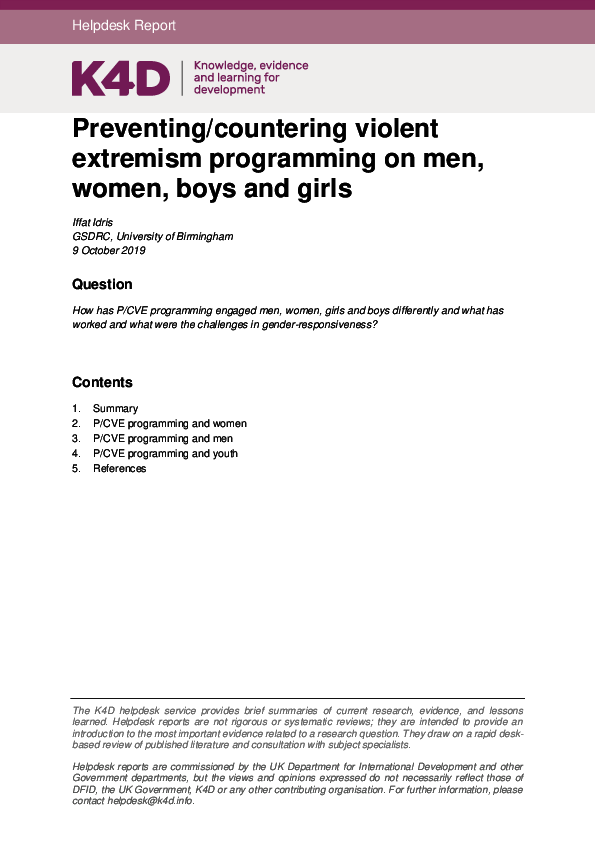
Study: Research
Preventing/Countering Violent Extremism Programming on Men, Women, Boys and Girls
Publication year:
2019
English
Format:
pdf (559.1 KiB)
Publisher:
K4D, Knowledge, Evidence, and Learning for Development
The literature stresses the importance of taking a gendered approach in Preventing/Countering Violent Extremism (P/CVE) programming. Women’s participation can bring different perceptions and experiences, and ensure increased effectiveness and broader reach of P/CVE strategies. In recent years there has been a significant shift towards adopting a gender perspective in P/CVE frameworks and strategies. Recommendations for P/CVE programming and women fall into three broad themes: conduct more research and gendered analysis; involve women and women’s organisations in all aspects of programming, and mainstream gender into all P/CVE work, whilst promoting gender equality in its own right. Gender is not the same as women. However, there is a tendency to equate gender with women and overlook men and male youth. One consequence of this is a lack of focus and research on men, male youth and masculinity in the context of violent extremism. Gender roles, and patriarchal notions of masculinity in particular, can fuel conflict and insecurity, and be a driver of violent extremism. Key recommendations include: the need to understand gendered push and pull factors behind violent extremism, and not make assumptions about men’s roles; greater research and focus on notions of masculinity in the context of violent extremism; and promotion of ‘positive’ notions of masculinity (not based on violence). The majority of people who become violent extremists are youth but only a tiny proportion of youth populations end up in violent extremist groups. The factors driving youth involvement in violent extremism are complex, diverse and often mutually reinforcing. Key recommendations are: carry out thorough analysis on violent extremism in each localised context, who’s involved/vulnerable, driving factors, and determine interventions accordingly; involve youth in data collection and analysis, and design and implementation of programmes; promote multi-stakeholder partnerships with youth at the forefront; engage in advocacy and awareness-raising on the positive role and needs of young people for PVE; promote young women’s empowerment and gender-sensitive youth and PVE approaches; and try to reach ‘unreachable’ youth.
Read full abstract
Authors
View & Download
Document information
Authors
Format
Content type
Rights
© Author/Publisher
Found a mistake? Help us improve!
If you have noticed a document assigned to the wrong author or any other inaccuracies, let us know! Your feedback helps us keep our data accurate and useful for everyone.
Share
Link
